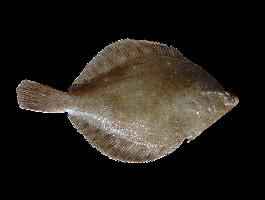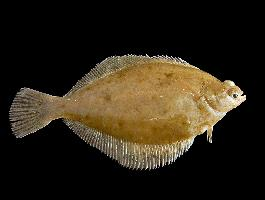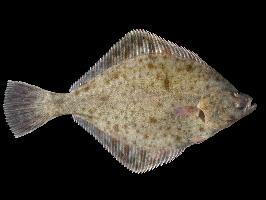
Poids et mesures
| Longueur | de 25 à 40 cm |
|---|
Description de l'animal
The European plaice (Pleuronectes platessa) is a fascinating species of flatfish that is predominantly found in the sandy bottoms and mudflats of the North Atlantic Ocean and the Baltic Sea. This species has adapted remarkably to its benthic lifestyle, exhibiting several unique features and behaviors that make it a subject of interest both ecologically and commercially.Morphologically, the European plaice is characterized by its asymmetrical body, a common trait among flatfish, where both eyes are located on the right side of its head. This adaptation allows the plaice to lie flat on the seafloor, blending seamlessly with its surroundings, thus evading predators and ambushing prey. The body of the European plaice is oval-shaped, and it can grow up to 100 cm in length, although a more typical size is around 50 cm. The skin is smooth with a distinctive greenish-brown color on the eyed side, which is mottled with conspicuous orange-red spots, providing excellent camouflage against the sandy or muddy bottoms. The blind side, in contrast, is pearly white.
European plaice undergo a fascinating metamorphosis during their early life stages. They hatch as symmetrical larvae with one eye on each side of their head. As they mature, one eye migrates to the other side, and their body flattens, preparing them for a life spent on their side. This process is a remarkable example of evolutionary adaptation to their specific ecological niche.
The diet of the European plaice primarily consists of benthic invertebrates, such as polychaete worms, mollusks, and crustaceans. They are nocturnal feeders, using the cover of darkness to venture from their hiding spots in search of food. During the day, they remain buried under the sand or mud, with only their eyes protruding, to avoid predators.
Reproduction is another interesting aspect of their biology. Spawning occurs from late winter to early spring, and it is highly dependent on the temperature of the water. Females can lay up to half a million eggs, which are fertilized externally. The eggs float in the water column until they hatch, and the larvae begin their planktonic life before settling to the bottom and starting the transformation into adult form.
The European plaice holds significant economic value, particularly in European countries, where it is a common target for commercial fisheries. It is appreciated for its delicate flavor and fine, white flesh, making it a popular choice for culinary use. However, like many marine species, it faces threats from overfishing, habitat destruction, and pollution, which have led to declines in some populations. Conservation measures and sustainable fishing practices are crucial to ensure the long-term survival of this interesting and valuable species.
In summary, the European plaice is a remarkable flatfish with unique adaptations to its benthic lifestyle. Its life cycle, behavior, and ecological role make it an intriguing subject of study, while its economic importance underscores the need for careful management and conservation efforts.
Animaux similaires
Nouvelles photos d'animaux
Top 10 des animaux
- Dolphin gull (Leucophaeus scoresbii)
- Diana monkey (Cercopithecus diana)
- Moustached guenon (Cercopithecus cephus)
- Galápagos tortoise (Geochelone nigra complex)
- Russian tortoise (Testudo horsfieldii)
- Stone loach (Barbatula barbatula)
- Japanese macaque (Macaca fuscata)
- Greek tortoise (Testudo graeca)
- Common flying dragon (Draco volans)
- Vendace (Coregonus albula)

